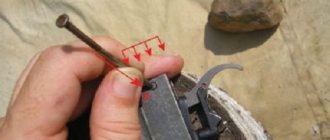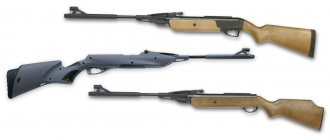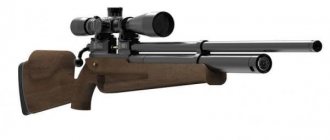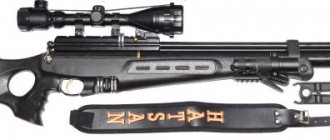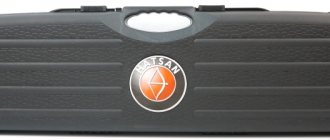Features of a modern air rifle for biathlon
Today, according to the rules, biathletes must use only small-caliber weapons that fire rimfire cartridges with a caliber of 5.6 mm and weighing from 2.58 to 2.61 g. This caliber is called “.22 Long Rifle”. This phrase translates as “long rifle.” The magazine with the clip is placed on the butt or in the front of the stock. One clip contains up to 5 charges.
The average number of rounds fired by a biathlete per month is 1,200.
Spring-piston and gas-cylinder rifles can be used. Most athletes prefer the latter. Each rifle has a wooden stock, which is usually made individually, based on the anatomical characteristics of the athlete. There is also a bolt device, a barrel, a magazine, a muzzle and a diopter sight. A shoulder strap is included. The optical sight should not magnify. The weight of the product is on average 3.5 kg.
Professional athletes prefer to use rifles from two manufacturers for competitions: the German company Anschutz and the domestic manufacturer IzhMash. Note that they are fierce competitors - the rivalry between them began at the end of the last century. Each manufactured sample undergoes a thorough check, and the target, shot at the factory shooting range, is certainly pasted into the rifle’s passport. Next, let’s compare the two most popular models: Russian and German. Both of them work according to the PCP scheme.
Domestic rifle BI 7-4
Air rifle BI 7-4
These weapons began to be manufactured in 1991 at the famous Izhevsk plant. Over the past years, it has been repeatedly modernized and improved. The stock, shoulder strap, barrel, sight and other parts were changed. Thus, version 4A has an Anschutz barrel, and version 9 has a stock that can be customized for a specific shooter and an Anschutz sight. It should be noted that for athletes, assembled rifles are made to special order.
The caliber of the rifle is 5.6 mm, it weighs 4.5 kg and is 1.05 m long. Of this, 0.5 m is on the barrel. The back of the butt can be adjusted in length by 2 cm. The cheek of the butt can be adjusted by 0.75 cm vertically and 0.6 cm horizontally. The travel of the trigger is also adjustable to 0.2-0.4 cm. All this makes it possible to aim as accurately as possible. To protect the front sight, sight and barrel from snow, dust and dirt, hinged covers are provided. The trigger has a trigger type.
Removable magazines are designed for five charges. They are installed on the butt - for this purpose there is a cassette for four magazines. In addition, the kit includes additional magazines with a cover, designed for three charges. For balancing, special weights are used that can be easily removed. The original shoulder strap has comfortable spring elements.
You can buy a rifle from 80 to 120 thousand rubles (depending on the version).
Shutter operation diagram
When reloading, the shooter moves the handle, causing the bolt to move in an arc. To lock the barrel channel, a crank-type hinge-lever scheme is used. These are two elements, the connection between which is carried out using a hinge. The front part of the first part is on the same axis with the bolt, and the rear part of the second part is on the same axis with the receiver.
When the bolt reaches the forward position, the hinge reaches the “dead point”, going beyond it. It rests against the barrel box, and the bolt cannot be opened so easily. To open it, the shooter pulls the handle back, as a result of which the hinge comes out of the “dead zone”, and the parts of the locking unit fold, moving the bolt back.
Air rifles presented by the Izhevsk Mechanical Plant are distinguished by extreme reliability and the longest possible service life. The price of the IZH 38 air rifle is indicated in this article, as well as other features of this rifle. How much you can buy a Moran air rifle can be found on this page. Technical characteristics of this rifle and its features.
Advantages and disadvantages
Great:
- Reasonable price coupled with excellent quality and reliability.
- Compared to Anschutz BI 7 locks better.
Not very good:
- The rifle's accuracy is lower than that of the Anschutz.
- In cold weather, malfunctions occur when using Lapua cartridges.
- Not the best customer service. Repairs require a lot of paperwork and taking the rifle to the factory. And at competitions abroad, no one will help at all.
Modern biathlete's rifle
The biathlon rifle began its evolution in 1948, when the International Federation of Modern Pentathlon appeared. At the same time, the biathlete’s cartridges have not changed since 1888 - 5.6 caliber, rimfire, with a small amount of gunpowder. This cartridge gives low recoil, which is important for accuracy and accuracy.
But there were different designs and manufacturers of rifles, but today the vast majority of biathletes compete with the Anschutz-Fortner 1827F (price from $3,000). Even Russian athletes often refuse domestic products in their favor, although at the Olympics in Vancouver (and, of course, at the home Olympics in Sochi) they competed with Izhevsk Bi-7-4 from the Biathlon series.
Technical characteristics of the Anschutz-Fortner rifle for biathlon:
- Weight - 3.63 kg;
- Barrel length - 730.25 mm;
- Total length - 1,041.4 mm;
- Caliber - .22;
- Magazine capacity - 5 rounds;
- Walnut stock, adjustable cheekpiece, adjustable trigger.
Professional rifle models should not be confused with solutions like IZH-61. However, for training there is a separate series of BI-7 rifles, made at Izhmash. A modern BI-7-5 costs around 90,000 rubles. It is easier for a young biathlete to get used to small arms. The caliber of such pneumatics is not 5.6, but 4.5 mm.
The pneumatic "Biathlon-7-5" is built according to a weapon design with preliminary injection of a high-pressure cylinder (PCP) and is used in summer and children's biathlon. In terms of weight and dimensions, it corresponds to BI-7-4, so you can train with it even in a regular pneumatic shooting range. The firing range is 10 m, charging the cylinder is enough for 200-250 shots. Bi-7-4 and Bi-7-5 weigh 4.5 kg. Compared to their predecessors, the rifles have “lost weight” by 500 grams.
Technical characteristics of the Biathlon-7 rifle:
| Characteristic | Biathlon-7-3 Biathlon-7-3A | Biathlon-7-4 Biathlon-7-4A |
| Caliber, mm | 5.6 (.22LR) | 5.6 (.22LR) |
| Cartridge used | 5.6 (.22LR) | 5.6 (.22LR) |
| Weight, kg | 4 | 4,5 |
| Barrel length, mm | 500 | 500 |
| Trigger force adjustment limits, kgf | 0,5…1,0 | 0,5…1,0 |
| Store capacity, pcs. cartridges | 5 | 5 |
| The amount of adjustment of the back of the butt in length, mm | 30 | 20 |
Butt cheek adjustment amount, mm
|
|
|
| The amount of adjustment of the working stroke of the trigger, mm | 2..4 | 2..4 |
| Overall dimensions, mm | 1035x90x290 | 1050x90x290 |
The Biathlon-7-4 sports rifle is a small-caliber (small-caliber) rifle chambered for 5.6 mm (.22LR). The rifle is considered a men's rifle. The butt length is adjustable. The rifle is produced for right-handers and left-handers, there is an option with a safety lock.
At the Olympics in Sochi, Russian biathletes competed with BI-7-4
Anschutz 1827 Fortner
Air rifle Anschutz 1827 Fortner
This popular rifle with a unique bolt design has been produced by the German concern Anschutz since the late eighties of the last century. Now two versions are produced: regular and sprint (which allows you to install a heavy barrel). The first type carries 4 kg, the sprint model – 3.7 kg. When installing a heavy barrel, the weight of the latter reaches 3.85 kg. There is a diopter sight and a ring front sight. The barrel and sight are protected by rubber plugs. The 5.6 mm cartridge flies out at a speed of 340 meters per second.
The length of the rifle is almost no different from the BI 7 - this parameter is 1.04 m. The barrel with eight rifling with a pitch of 335 mm has a length of 0.55 m. The stock is made of walnut. The butt has a cheek, the position of which can be adjusted in terms of inclination and height. The aluminum buttplate can be adjusted in length.
The video shows a comparison of biathlon rifles, competitors Bi 7 and Anschultz:
The magazine cassette is located on the forend, and next to it there is a compartment for six additional charges. The 5-round magazine can be standard or extended (with a holder for three additional cartridges). The bottom of the magazine is bright red - this is convenient, as it prevents the sides from being mixed up when attaching it. Removing it is also easy - for this there is a large lever located in front of the trigger guard. The trigger itself has a stepless adjustment mechanism.
The price of the product ranges from 250 to 310 thousand rubles. This is a lot, but professionals prefer these rifles.
Shutter operation diagram
This scheme was invented by Peter Fortner, who patented his invention in 1984. Its “trick” is its lightning-fast reload. To lock the bolt, six balls are used, which are lugs. The mechanism is entered by pressing the index finger on a special handle. In this case, the balls come out of the bolt grooves and roll into grooves made in the receiver.
To return the bolt, simply press on the back side with your thumb.
In this case, the balls again take their original position.
Advantages and disadvantages
Great:
- Excellent mobile service base - the company has created a special service team accompanying biathletes.
- Very fast and convenient shutter operation, high accuracy.
- The external design looks very advantageous.
- Excellent quality of the barrel, made of special nitrided steel (it’s not for nothing that some Izhevsk models are equipped with a barrel from Anschutz).
- A large number of accessories (belts, devices for lubrication and cleaning, covers), as well as parts (barrels, receivers, stocks).
- The extractor and ejector have a special design that works reliably even in the cold.
Not very good:
- The firing pin of these rifles sometimes fails at the most inopportune moment (in 4 years it failed Russian athletes 2 times);
- The price is more than twice as high as that of Izhevsk models.
- The locking moment cannot always be clearly seen; sometimes some pressure is required.
Anschutz 1827 Fortner
Anschütz Fortner rifles come with an Anschütz 5020 trigger with an adjustable pull weight from 90 to 650 g (0.20 to 1.43 lb). [1] The trigger can be configured to operate as a one- or two-stage trigger. [ citation needed
] The straight-line mechanism uses seven hardened steel ball bearings evenly spaced around the back of the bolt as locking elements. As the bolt handle moves forward, it moves a retaining piece called the bolt sleeve forward, causing the ball bearings to come out and lock into a negative recess in the receiver. The receiver does not have corresponding negative shaped (concave) recesses. This would be very difficult to implement with the required level of precision. Instead, there is a simple continuous semi-circular groove into which the ball bearings are secured. The locking piece retracts when the bolt handle is pulled back, allowing the locking bearings to retract into the bolt body so that the bolt can open. The valve can be classified as a semi-rigid type, since the locking elements are movably mounted on the valve. [10] This mechanism was patented in 1984 and has expired. [11] [12] The crossbar can be classified as a semi-rigid type, since the fixing elements are movably mounted on the crossbar. The 1827F has a lock time of about 1.7 milliseconds [13], which together with a lag time (ignition delay plus barrel time) of about 2.3 ms gives a total time of about 4 ms from the moment the trigger is pulled to the time the bullet exits the barrel. [14]
To prevent firing pin damage during dry fire, the user must install an optional firing pin buffer (also called a "Dry Fire Donut"). [15]
The bolt barrel is made by Fortner Waffen and has a length of 730 mm. Despite being in production for almost 40 years, the barrel has remained virtually unchanged. All accessories and other parts are compatible throughout all years of production. For example, triggers from any production year are technically the same and compatible. The main improvement was in the barrel, as some early models used non-nitrated barrels, but these are rare to find. The barrels are not threaded, but are pressed into the receiver, [ citation needed
] and can be replaced by a competent gunsmith.
Like other high-quality .22 LR sporting barrels from Anschütz, the muzzle is dead-bore, supposedly for better cold-weather performance. [ citation needed
] The bolt has a safety located on the side of the receiver, where the letter "S" indicates
Sicherung
(meaning "safety" in German) and the "F" indicates
Feuer
(meaning "fire" in German ). [16]
Factory stocks are made by Anschütz and stock designs have changed slightly over the years. The modern Anschütz design features adjustable cheek support and pull length to suit a variety of athletes. It is not uncommon for athletes to purchase substandard or non-genuine supplies from other brands, and these cannot always be adjusted.
1827 Fortner magazines are compatible with curved [17].22 LR magazines for the Anschütz 1400 and 1700 sporting series, as well as the Anschütz 54 and 64 magazine versions for target shooting. [18] However, magazines specifically designed for biathlon differ in that they have a special support plate for ease of use with gloves. [18]
Sight adjustment on Fortner biathlon rifles is most often clockwise (CW) with a click value of 0.06 mrad, which corresponds to 3 mm at the 50 meter range used in competition (or equivalently 6 mm when training outdoors at the range 100 m and 0.9 mm when training indoors at 15 m). [19]
The Anschütz 1827F's main competitor today is the 7-3 and 7-4 series of tumbler rifles made by the Russian Izhmash, [20] and both mechanisms require only about 2.5 kgf to cycle, and can be cycled in less than 1 second. However, when using the Fortner direct action, the shooter closes the slide with the thumb, allowing the index finger to reach the trigger more quickly. [21]

